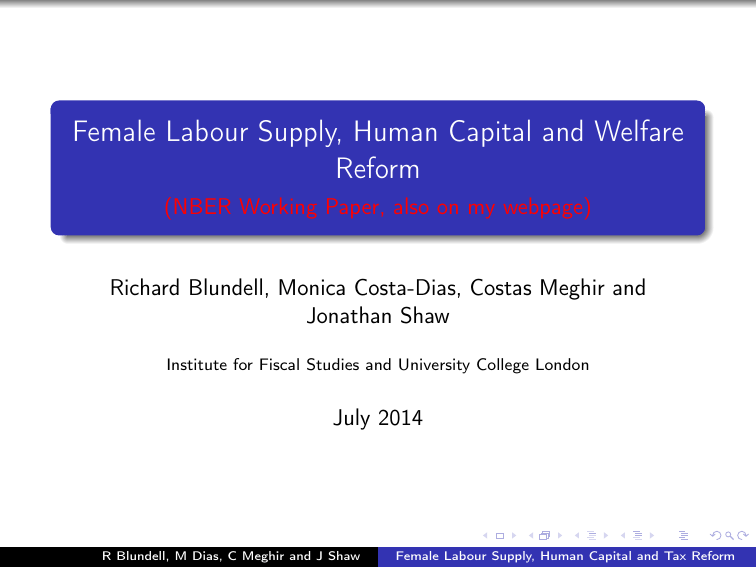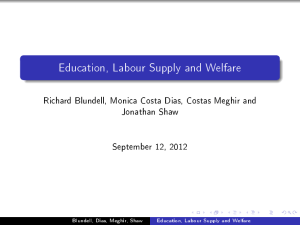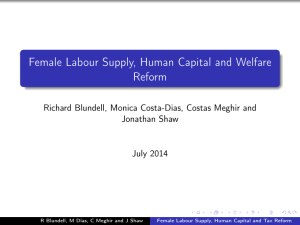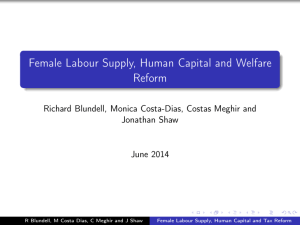Female Labour Supply, Human Capital and Welfare Reform
advertisement

Female Labour Supply, Human Capital and Welfare Reform (NBER Working Paper, also on my webpage) Richard Blundell, Monica Costa-Dias, Costas Meghir and Jonathan Shaw Institute for Fiscal Studies and University College London July 2014 R Blundell, M Dias, C Meghir and J Shaw Female Labour Supply, Human Capital and Tax Reform Motivation Issues to be addressed: 1 How should labour supply, work experience dynamics and education decisions be accounted for in the evaluation of tax and welfare reform? 1 2 Especially in the design, and in the impact evaluation, of transfers to low wage families in the form of ‘in-work benefits’ or ‘earned income tax credits’. Focus here is on the labor supply, experience and education decisions of women. 2 What is the ‘insurance value’ of redistributive policies of this kind? And how does the trade-off between insurance and incentives play out? 3 Unravel the way the two aspects of human capital interact with labour supply decisions at the extensive and intensive margin. R Blundell, M Dias, C Meghir and J Shaw Female Labour Supply, Human Capital and Tax Reform Policy Background Tax and Welfare Reform in the UK: We study a specific reform - Working Families Tax Credit (WFTC) and Income Support (IS) in 1999/2000. This involved an increase in the generosity of the welfare and earned income tax credit system for families with children. A motivation for these policies is that by incentivising women into work, even when they have young children, preserves labour market attachment and reduces skill depreciation. An additional peculiarity of the UK tax-credit system is the minimum hours eligibility rules that focus incentives on part-time work. R Blundell, M Dias, C Meghir and J Shaw Female Labour Supply, Human Capital and Tax Reform The UK (WFTC) Tax Credit and IS Reform IS and Tax credit award for lone parent with 1 child 400 Net family income (£pw) 0 0 IS + tax credit award (£pw) 50 100 Net family income (£pw) 100 200 300 150 IS and tax credit award (£pw) 0 10 20 30 40 Hours of work (pw) 1999 50 0 IS reform R Blundell, M Dias, C Meghir and J Shaw 10 20 30 40 Hours of work (pw) 50 WFTC reform Female Labour Supply, Human Capital and Tax Reform Impact on married women in couples The budget constraint for second-earner parents 400 Net family income (£pw) 0 0 IS + tax credit award (£pw) 50 100 Net family income (£pw) 100 200 300 150 IS and tax credit award (£pw) 0 10 20 30 40 Hours of work (pw) 1999 R Blundell, M Dias, C Meghir and J Shaw 50 0 10 20 30 40 Hours of work (pw) 50 WFTC reform Female Labour Supply, Human Capital and Tax Reform Do the hours rules impact on observed behaviour? The Distribution of Weekly Hours of Work: 1993 FRS Low Education Single Women with and without Children. R Blundell, M Dias, C Meghir and J Shaw Female Labour Supply, Human Capital and Tax Reform Policy Background The key question we ask is: How do the features of this broad kind of tax, tax-credit and welfare benefit system affect education choices, experience capital accumulation, employment and hours of work over the life-cycle? The approach we take: A structural evaluation/estimation approach, using the time series of tax, tax credit, welfare benefit and tuition reforms for new cohorts of women to identify parameters. Conditioning on life-history family background variables. Comparing with Diff-in-Diff/quasi-experimental contrasts where possible. R Blundell, M Dias, C Meghir and J Shaw Female Labour Supply, Human Capital and Tax Reform Data British Household Panel Survey (BHPS) Unbalanced panel of 4,200 females over 17 waves, 1991-2007 Measures of education, labour market outcomes, work-related and not-work-related training, childcare, detailed demographics, (limited) assets information. IFS taxben working on every wave: Taxes: income tax, NI, council tax Benefits: child benefit, maternity grant, tax credits, income support, housing benefit, council tax benefit, free school meals Linked life histories capture choices at age 16: educational qualifications; and detailed family background measures, including parental education, number of siblings, sibling order, whether lived with parents when aged 16, books at home as a child, etc R Blundell, M Dias, C Meghir and J Shaw Female Labour Supply, Human Capital and Tax Reform 1.6 1.8 log wage 2 2.2 2.4 2.6 Wage Profiles by Education by Age 20 30 40 50 age secondary R Blundell, M Dias, C Meghir and J Shaw further higher Female Labour Supply, Human Capital and Tax Reform Employment over the life-cycle Part−time employment employment rates .1 .15 0 .5 .6 .05 employment rates .7 .8 .2 .9 .25 1 All employment 20 30 40 50 20 age secondary R Blundell, M Dias, C Meghir and J Shaw 30 40 50 age further higher Female Labour Supply, Human Capital and Tax Reform Employment of mothers Part−time employment .4 0 .6 .1 .2 .8 .3 1 All employment −3 0 3 6 9 12 15 years to childbirth 18 21 −3 0 3 6 9 12 15 years to childbirth 18 21 secondary further higher R Blundell, M Dias, C Meghir and J Shaw Female Labour Supply, Human Capital and Tax Reform Key Model Features Estimate a dynamic model of labour supply and human capital. Life in three stages: Education ‘s=0,1,2’: three levels chosen sequentially up to age 18/21 secondary (GCSE-level at 16), further/high school (A-levels or vocational at 18), higher (university and college at 21) Working life: consumption ‘c’ and asset ‘a’ accumulation labour supply ‘l’ (0, part-time or full-time) experience accumulation partnering childbearing Retirement: pension incomes take effect exogenously at age 60 R Blundell, M Dias, C Meghir and J Shaw Female Labour Supply, Human Capital and Tax Reform Model: female earnings Wage equation for individual ‘i’, age ‘t’, in each birth cohort; with school level ‘s’, experience ‘e’, labour supply ‘l’ ln wsit = ln Wsit + γs ln (esit + 1) + υsit + ξsit υsit = ρs υsit−1 + µsit esit = esit−1 (1 − δs ) + gs (lsit ) g (lsit ) set to unity for full-time, part-time is estimated. persistence of shocks - distinguish heterogeneity from state dependence (experience effects). ξsit is a transitory shock/measurement error. correlation of initial shock with preferences. concave profile of experience effects. depreciation of human capital - cost of not working. R Blundell, M Dias, C Meghir and J Shaw Female Labour Supply, Human Capital and Tax Reform Family formation dynamics Children: Children are born with an (weakly) exogenous arrival rate, h i k Prob t k = 0 t, s, kt−1 , tt−1 , mt−1 Partner: Arrival rate depending on level of education and age, m Prob stm t, s, mt−1 , st−1 , kt−1 =>> Feed these into a dynamic discrete choice model for labour supply and human capital with net worth borrowing contraints and unobserved heterogeneity. R Blundell, M Dias, C Meghir and J Shaw Female Labour Supply, Human Capital and Tax Reform Parameter Estimates Female wage equation estimates (Method of Simulated Moments) Secondary Further Higher wage rate (0 experience) 4.5 (.01) 4.9 (.02) 6.3 (.03) returns to experience .14 (.01) .23 (.01) .28 (.01) autocorrelation coef .92 (.00) .95 (.00) .89 (.01) se innovation .13 (.00) .13 (.00) .12 (.01) initial prod .10 (.01) .10 (.01) .20 (.01) initial productivity: se .30 (.01) .26 (.01) .26 (.03) depreciation rate .12 (.02) .11 (.01) .11 (.03) accumulation of HC in PTE .15 (.01) .12 (.01) .10 (.01) R Blundell, M Dias, C Meghir and J Shaw Female Labour Supply, Human Capital and Tax Reform −.8 experience gap (wage units) −.6 −.4 −.2 0 Part-time Experience Penalty 20 30 secondary R Blundell, M Dias, C Meghir and J Shaw 40 age 50 further 60 higher Female Labour Supply, Human Capital and Tax Reform Model fit 1.6 1.8 log wage 2 2.2 2.4 2.6 Life-cycle profiles of wages 20 30 40 50 age data, secondary data, further data, higher R Blundell, M Dias, C Meghir and J Shaw simulations, secondary simulations, further simulations, higher Female Labour Supply, Human Capital and Tax Reform Model fit Distribution of female wage rates by age Percentiles 10, 25, 50 75 and 90 20 30 40 50 1.5 log wage 2 2.5 3 Higher education 1 1.5 log wage 2 2.5 3 Further education 1 1 1.5 log wage 2 2.5 3 Secondary education 20 age 30 40 50 age data R Blundell, M Dias, C Meghir and J Shaw 20 30 40 50 age simulations Female Labour Supply, Human Capital and Tax Reform Model fit Employment over life-cycle Part−time employment .15 .1 .8 .05 .7 .5 0 .6 employment rates .9 .2 1 .25 All employment 20 30 40 50 age data, secondary data, further data, higher R Blundell, M Dias, C Meghir and J Shaw 20 30 40 50 age simulations, secondary simulations, further simulations, higher Female Labour Supply, Human Capital and Tax Reform Model fit Employment of mothers Part−time employment .4 0 .6 .1 .2 .8 .3 1 All employment −3 0 3 6 9 12 15 years to childbirth 18 21 data, secondary data, further data, higher R Blundell, M Dias, C Meghir and J Shaw −3 0 3 6 9 12 15 years to childbirth 18 21 simulations, secondary simulations, further simulations, higher Female Labour Supply, Human Capital and Tax Reform Comparison with DiD WFTC and IS Reforms for Lone Mothers % Point employment impact and matched diff-in-diff for low educated lone parents: 1999 - 2002 Simulations Matched Diff-in-diff R Blundell, M Dias, C Meghir and J Shaw Average Impact +3.9 +3.6 (0.5) Female Labour Supply, Human Capital and Tax Reform Marshallian Elasticities by Age: Extensive .1 participation elasticities .2 .3 .4 .5 marshall elasticities 20 30 40 50 age all further R Blundell, M Dias, C Meghir and J Shaw secondary higher Female Labour Supply, Human Capital and Tax Reform −1 −.8 income effects −.6 −.4 −.2 0 Income Effects at Extensive Margin by Age 25 30 35 40 45 50 age all further R Blundell, M Dias, C Meghir and J Shaw secondary higher Female Labour Supply, Human Capital and Tax Reform Results: Impact of WFTC & Child IS Reform Revenue Neutral Reform, basic tax rate adjustment I. Impact on Employment of Younger Women: No Education Choice Single Mother Sec. Fur. Uni. employment 3.8 1.5 -0.5 Couple with Kids Sec. Fur. Uni. -2.5 -1.2 -0.8 II. Impact on Education Shares: 1999 2002 Sec. 30.4 31.2 R Blundell, M Dias, C Meghir and J Shaw Fur. 47.5 47.2 Uni. 22.1 21.6 Female Labour Supply, Human Capital and Tax Reform Results: Impact of WFTC & Child IS Reform Revenue Neutral Reform, basic tax rate adjustment I. Impact on Employment of Younger Women: No Education Choice Single Mother Sec. Fur. Uni. employment 3.8 1.5 -0.5 Couple with Kids Sec. Fur. Uni. -2.5 -1.2 -0.8 II. Impact on Education Shares: 1999 2002 Sec. 30.4 31.2 R Blundell, M Dias, C Meghir and J Shaw Fur. 47.5 47.2 Uni. 22.1 21.6 Female Labour Supply, Human Capital and Tax Reform Risk Aversion and the Value of Insurance −1 % change in consumption 0 1 2 Willingness to pay in consumption .5 1 1.5 variance of innnovations in female wage rates secondary R Blundell, M Dias, C Meghir and J Shaw further 2 higher Female Labour Supply, Human Capital and Tax Reform Summary and Discussion Experience effects are lower for the lower educated and for those in part-time work, explaining the part-time penalty. Women with low labour market attachment have more elastic labour supply at younger ages and large income responses. There is a small effect of tax credits on education choice, with some women obtaining less education, and attenuating the employment gains of the reform. The insurance value of the welfare program is substantial, particularly for the lowest education/skill groups. The results can explain previous structural and quasi-experimental results for the WFTC/IS, and similar, reforms. Next steps: sector choice, training, and frictions. R Blundell, M Dias, C Meghir and J Shaw Female Labour Supply, Human Capital and Tax Reform Extra Slides R Blundell, M Dias, C Meghir and J Shaw Female Labour Supply, Human Capital and Tax Reform Training participation rates by age and education Work−related training participation rates (50h+) 20 30 40 age 50 60 .15 0 .05 .1 .15 .1 .05 0 0 .05 .1 .15 .2 High Ed .2 Medium Ed .2 Low Ed 20 30 Men R Blundell, M Dias, C Meghir and J Shaw 40 age 50 60 20 30 40 age 50 60 Women Female Labour Supply, Human Capital and Tax Reform







